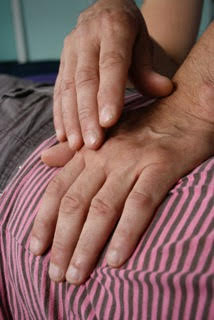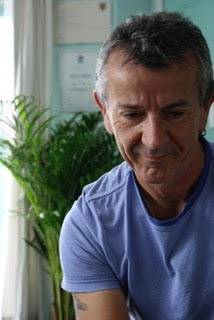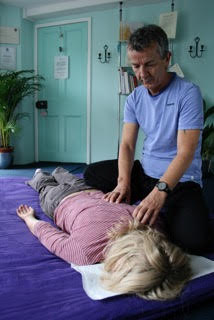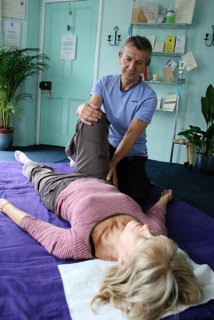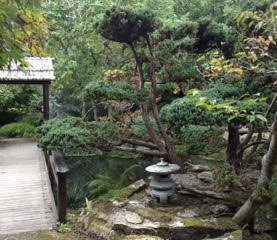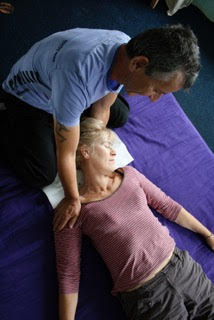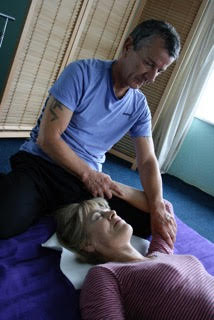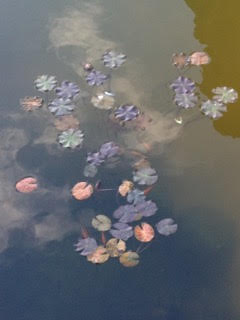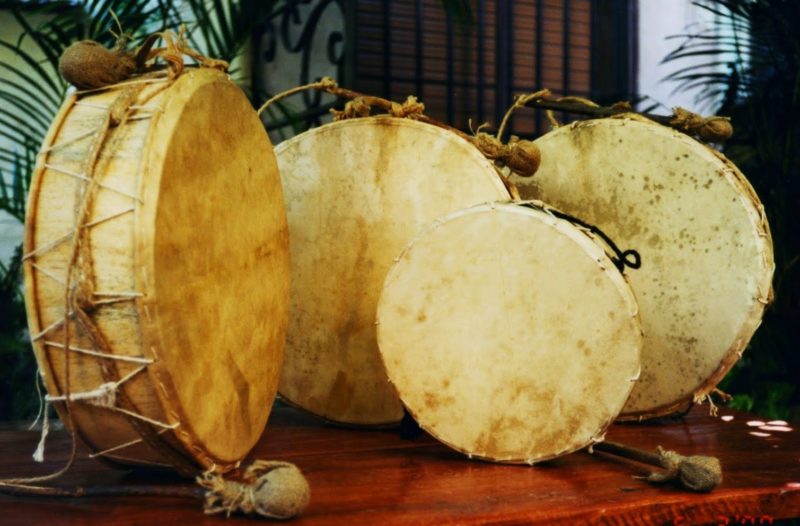A Touch of Shiatsu
AN ORIENTAL APPROACH TO BODYWORK AND WELL-BEING
Graham Crisp is a Shiatsu practitioner and teacher with almost 30 years experience.He was a co-founder of The Ki Kai Shiatsu Centre in North London and is now a senior teacher on the professional training course in Shiatsu at Morley College in Lambeth.Alongside his private practice he has been employed by the charity Turning Point for over 25 years, offering Shiatsu treatments to people with drug and alcohol problems.
Please explain to us, what exactly is Shiatsu?
Shiatsu is a Japanese bodywork, based on the principles of Traditional Chinese Medicine. It is performed through loose clothing at ground level, on a mat or futon. Treatments last around one hour, often a little longer the first time to allow a full case history to be taken, the actual bodywork usually taking about 50 minutes. The practitioner will first make a diagnosis through discussion, observation and palpation, and then treat the client using a wide variety of techniques, ranging from deep touch, to dynamic stretches to gentle holding. Each treatment is a direct response by the practitioner to the client’s energy and therefore varies somewhat each treatment. Some time may be allowed at the end of the session to discuss recommendations that the practitioner may have, such as exercises, diet and lifestyle.
How can we benefit from Shiatsu?
The stresses and strains of modern life take their toll on us both physically and mentally. Shiatsu is a great therapy for bringing us back into our bodies. It gives us a space to just be, something we don’t normally remember to do! Allowing the mind to follow the practitioner’s hands as they move enables us to feel the state of our Qi, and to be aware of aches and pains which we probably have not been aware of. The client enters a state of deep relaxation as their breath deepens. After a treatment there is usually a sense of either feeling invigorated or simply just more whole. Of course for many people there is also the benefit of feeling less pain in problem areas.
Can Shiatsu affect a person on an emotional as well as a physical level?
Absolutely. In Chinese medicine each of the internal organs has a direct relationship with an emotion. For instance the liver is related to the emotion anger. When the liver is not fulfilling its function of allowing Qi to flow freely through the body, blockages and stagnation can occur. When stagnation occurs we feel frustrated, our muscles become tight and stiff and our joints become less mobile. We may start to move in a more ‘militaristic’ manner and a sense of pent up anger may be felt. Another example is the association between the lungs and the emotion of grief. This can be seen in the posture of some people: the caved in chest which manifests from weak lung energy can lead to ongoing feelings of melancholia or depression. My aim as a practitioner is to physically bring the client’s attention to these sorts of problems. By holding acupuncture points and stimulating the associated meridians/channels, the client’s emotions are re-harmonised as well as their body.
Can Shiatsu benefit all ages, from tiny babies to frail, elderly people?
Yes it can. Shiatsu incorporates many ways of working, from light touch, sometimes even off–the-body work, to deep pressure, from dynamic stretches to simple holding techniques. Obviously the techniques a practitioner uses depends on the energetic state of the client. Over my years as a practitioner I have been privileged to work with a wide range of ages. I have also worked with clients who have had terminal illnesses; whilst they didn’t come for treatments to cure their conditions and were still receiving allopathic treatment, they found the Shiatsu beneficial in improving the quality of the time they had remaining. The quiet stillness of some of those treatments has led to some of my most rewarding sessions.
A bewildering array of complementary treatments is available nowadays: acupuncture, reiki, craniosacral therapy, kinesiology, ayurveda, chiropractic, rolfing, reflexology... the list goes on and on! How can we choose between them?
Indeed there are many, with new ones appearing regularly. I always think it’s best to do a bit of research about what each therapy offers and entails. Some people are drawn to various different kinds of bodywork, for some people bodywork doesn’t feel right. Some people are drawn to energetic work, some to very physical manipulations. Recommendations are always a good place to start; if you know someone who has been very happy with treatments they’ve received that’s a good introduction. Otherwise follow your instinct as it’s a part of our natural ability to be able to judge what is useful for us. I would say that whatever therapy you choose make sure the practitioner is fully qualified by the relevant governing body. My final thought is to find someone who you can work with and trust. An essential part of going through any process is to be able to feel safe.
Would you say Shiatsu is a preventive medicine?
Shiatsu can be very useful as a preventive medicine. Quite often in our busy lives we forget to look after our bodies and we only become aware of them when something goes wrong. As we get older muscles can become tighter and our range of movement may diminish. Regular Shiatsu treatments involving stretches and joint mobilisations can help us keep a good range of mobility. Stretching can also help us to ensure correct posture by lengthening tight muscles that are pulling areas of the body away from their intended position. The very act of stretching increases the flow of blood to the muscles. Alongside the physiological benefits there is also the fact that sessions enable the body to enter a deep state of relaxation whilst maintaining attention. We all need that space to be able to recharge and renew at an energetic level. Finally not to forget that it feels great to receive Shiatsu.
Is it better to refrain from talking during a session?
That’s an interesting question! When I first started treating people I used to think that it was their time and so if they wanted to talk during the session that was fine. However, during a treatment my intention is to bring a client’s focus to areas of the body that may have a feeling of stagnation, “stuckness”, or just a general feeling of emptiness and thus having the client’s attention on the session can be more effective. There’s a saying in Japan, ‘Where the mind goes, the Qi follows’. Sometimes talking may be a client’s way of not fully engaging in the treatment. However, for some people, being able to talk through the treatment allows them to relax more. If after a few sessions though, I feel the client is using talking as a way to not engage fully in the process, I may suggest that they concentrate on the points I am working, or breathe into the stretches. Certainly most people comment that they find the session more effective if they allow themselves to properly feel it.
Is it possible to put into words how a Shiatsu practitioner senses a person’s Qi or life energy?
I think we all do this at some level, though we may not be aware of it. We all notice people who have a sense of vitality about them, the sparkling eyes, the enthusiasm for life, the easy laughter. Likewise people who seem tired at a deep level, the lack of engagement in a voice, the stooped posture. We notice people who seem to be ‘grounded’ or a bit ‘spacy’. The Shiatsu practitioner does this consciously from the very first meeting and throughout the treatment through observation and listening. As in all activities, the more we do this the better we get at it. Shiatsu practitioners also have the wonder of being able to feel Qi in the body through touch. In Shiatsu we use the terms Kyo and Jitsu. Kyo has the quality of emptiness, lacking in Qi, in which case areas may feel cold, lacking resistance, with no ‘bounce’. Jitsu, obviously, has the opposite quality, a sense of fullness, tightness, rigidity, possibly hot to the touch, quite often “stuckness”. Our intention as therapists is to try and bring a balance between the two extremes, to tonify the Kyo areas and channels and to disperse and sedate the Jitsu.
Modern life can be so very stressful! Can you give us some tips on how to protect ourselves from negative influences which may affect our well-being?
I think it’s really important to be able to ‘turn off’ from the hustle and bustle of modern life and spend time doing something which connects us to that ‘still place’ inside. Taking time out to immerse ourselves in something which is life enhancing feeds us at a deep level. The Japanese have a word ‘kata’ which means training method, or formal exercise. The principle is that by practising a basic form or pattern of behaviour we can reach a degree of mastery in the activity. My personal kata is a mixture of Qi Gong (which is a Tai Chi-like exercise emphasising focus on breath and slow fluid movements) and meditation. It certainly helps to choose something you love in the first place. Your kata could be painting, gardening, playing music etc. The more we practise, the more the doing of a thing is as easy as thinking it.
Graham, how did Shiatsu come into your life?
I was in my mid thirties and had had a lot of jobs that didn’t really satisfy me at any deep level but which paid the rent. I’d always had a leaning towards Eastern philosophies and in my early twenties had practised meditation for several years. I also loved giving massage, although my methods were purely intuitive rather than from any formal training. I saw a flyer advertising an Introduction to Shiatsu weekend. As we went through the weekend I found myself nodding in agreement at pretty much everything the teacher was saying: the bodywork skills, the holistic way at looking at health, looking after ourselves, the emphasis on the ability to achieve the state of ‘empty mind’ and of course the wisdom of Traditional Chinese Medicine. At the end of the weekend I really felt that I had found something that I could immerse myself in. After practising for almost thirty years, and still having the passion for Shiatsu that I felt that first weekend, I guess I was right.
Have you spent time in Japan, learning with Shiatsu masters?
I’ve never been to Japan. I have been lucky enough to be practising Shiatsu during a time when lots of Japanese masters have come to England to run workshops. Shiatsu is definitely a therapy where the more teachers and styles you come into contact with, the more it enhances your practice and enables you to develop your own styles of working.
Where do you practice?
My practice is in Finchley, North London.
Do you as a practitioner tend to feel energised or tired after a treatment?
There’s a concept in Shiatsu of ‘beginner’s mind’, which is really a way of being in the moment and not making assumptions as to what you will find as you work. When someone lies down to receive a treatment my attention is in my hands, allowing me to still my mind so I can focus on listening and feeling for what’s happening as I work around the client’s body. That focus is like a breathing space for my busy mind. Like any form of meditation it means that you feel refreshed after immersing yourself in the here and now. Moving around at floor level, with an intention on remaining relaxed, also means that instead of the treatment coming from my muscle power it comes from me leaning my bodyweight as I work. This entails an awareness of what the Japanese call ‘hara’, basically the abdominal area. Breathing into the hara means that you really relax at a deep level, so if I’m working true to the principles of Shiatsu it’s doing me as much good as the client.
I know that you teach Shiatsu: can anyone at all learn this skill or only particularly empathic, sensitive, intuitive people?
After teaching for almost 25 years I’m pretty sure that anyone who has the desire can learn Shiatsu. What I’ve noticed in my teaching is that we all start from different strengths. Some students start with very strong intuitive skills, some with very sensitive hands, some with a giving, healing quality in their touch and some with none of these things! Many start having already practised martial arts before, so have a good understanding of Qi and how to use their body efficiently. Some people fall in love with the theoretical side of Chinese medicine. Of course for all of us who start training there are aspects which don’t come naturally to us, so the course is as much about our own personal growth as it is about refining our inherent skills.
How long does it take to become a Shiatsu practitioner?
Three years training to become fully qualified. The course is a combination of bodywork techniques, Traditional Chinese Medicine theory, Anatomy, Physiology, Pathology and self development exercises.
Are there any particular Eastern philosophies that you find compatible with Shiatsu?
For me, Taoism seems to encompass the principles of Shiatsu practice. It promotes achieving harmony or union with the universal Qi and living in accordance with the natural flow of the universe. It encourages discovering a set of practices, both internal and external, to aid keeping the body, mind and spirit strong. It also encourages us to develop a deep sense of internal stillness in the midst of everyday life.
Can you tell us one amazing healing story that you have witnessed?
I’ve witnessed some of the most amazing changes in people’s lives during my work at the Drug and Alcohol Centre in central London. Being part of a highly skilled team of professionals who offer many different types of intervention to people with drug and alcohol problems has been a real privilege. I think Shiatsu can offer support and grounding for people on the journey to an alcohol and drug free life. Many, many times clients have stood up after their treatments with big smiles on their faces, saying they feel happy in their bodies for the first time in years. It can be a really powerful experience. I love the way that over the years several people have been inspired enough by bodywork to choose to learn it themselves. There are at least two Shiatsu therapists and two osteopaths that I know of who made the leap from client in the project to practising therapists. It doesn’t get any better than seeing people turn their lives around.
Interviewed by Annie CleinFORM-Idea.com London, August 31st 2016.To contact Graham, please write to this email address: kikai@btopenworld.comwww.graham.crisp.shiatsusociety.org
